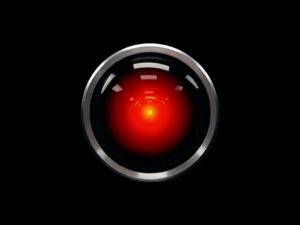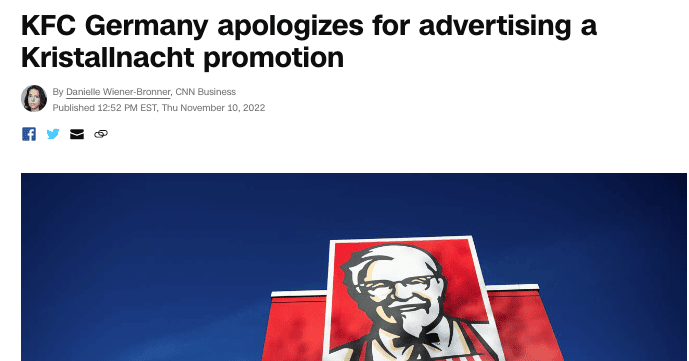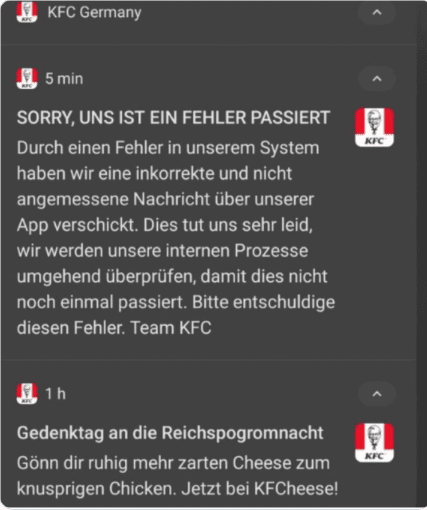Recently, KFC Germany experienced an AI content-driven PR disaster, which illustrates pitfalls that can accompany the deployment of dramatic technology for brands without appropriate human moderation.
The true writers among us – journalists, authors, scribes, poets, script writers, and experienced PR pros – almost unanimously turn our collective noses in the air at the mere utterance of “AI content.” Truthfully, our knee-jerk disdain may be a defensive move in many respects. Some AI tools are actually getting pretty savvy at spitting out useful block-and-tackle missives for websites, newsletters, news sites, and more. As such, data-generated content may pose a threat to (part of) our livelihoods.
At another level, though, the nose-in-the-air response is well deserved because the world still desperately needs excellent, researched, thought-provoking content. Beautifully sculpted essays, white papers, human stories, blog posts, editorials, scripts, and more represent far more than a bunch of words that convey a thought. Extraordinary writing elevates individuals to positions of great influence. Elegant use of words differentiates brands in powerful ways. Millions of people buy books, become engrossed in movies, or subscribe to news outlets simply because of emotive human storytelling that cannot be replicated by the bots. At least not yet. At minimum, brands still need some level of human moderation to prevent public-facing brand accidents.
But alas, it’s almost 2023 and technology is reshaping everything, including the content we consume. AI-generated content has earned a seat at the table. And, truth be told, it’s often hard to tell the difference between human-generated or AI-based content. That’s often, not always.
AI Content Run Amok
The machines can be effective at generating some of the day-to-day information sharing that just seems to appear. Great example – stories about college football bowl projections are little more than lather-rinse-repeat, stripping out the previous week’s data with fresh data based on the scores from Saturday’s games from across the country. Why pay a human to do that when a machine can scrape info and blast out content better, faster, and without tyops…typ[s. …ARRRRRRGH! TYPOS!
In marketing, AI-generated content has a number of potential applications. Basic blog posts can be mass produced in minutes. Social posts can align with specific holidays or promotions or search patterns to serve up content tailored for an individual user. Super powerful!
But just as countless thriller movies have proven to us, NEVER let the machines run without adult supervision. Case in point…
Yes. The headline is real. Bots did as they were instructed and served up ads tied to attributes surrounding lists of national observances. In this case, it was the Kristallnacht.
And yes, this reputation fail came out of KFC’s business in Germany, of all places.
Without delving too deep into history, The Kristallnacht was one of countless sinister moments of Nazi Germany. The US Holocaust Museum offers an exceptional narrative of what happened during a horrific 48-hour period surrounding November 9, 1938, including the cruel destruction of more than 7,500 Jewish-owned businesses, homes, and schools. It involved the murders of at least 91 Jews and the arrests of some 30,000 men who were taken to concentration camps. The Kristallnacht was a harbinger of the horrors to come over the next five years.
Fast forward to the November 2022 AI-generated “commemoration” of this historical event. The bots saw fit to send KFC app users content encouraging them to mark the day with crispy chicken and cheese.
To KFC’s credit, they quickly pulled the bot-generated content and replaced it with another clunky message noting the “error” that occurred. KFC subsequently offered a full apology and was forced to explain how bots were at the core of this egregious error. But, let’s face it, humans were equally culpable.
Bot-crafted AI content is only as good as the attributes keyed in and parameters set for creating the content – including the often-needed exclusions. We don’t know the specifics of how the Kristallnacht-related content actually came about, but it’s pretty easy to guess. A human imported or created a list of significant national commemorations. Bots were coded to pull basic information, such as dates, names of the commemoration, and then link to some mouth-watering product descriptors and images.
The bots did what bots do. They simply followed directions (they are mere code, after all).
Will this error destroy KFC? Probably not. But it’s one helluva well-earned dent in the brand. Apologizing was a good start. Fixing the problem will be an essential follow through.
How to Avoid AI Content PR Nightmares
It’s always easy to call this with 20/20 hindsight, but let’s just explore a few tips to hopefully avoid a brand-crushing PR nightmare created by the bots.
First, look critically at every attribute feeding bots, particularly for promotion-related content creation. Here’s just a few examples:
- Notable birthdays or anniversaries: Aside from Nazis, there are lots of other people or events brands should never align with, including corrupt people, notorious criminals, despicable politicians, and more.
- National holidays: Commemorating Labor Day is easy. Recognizing a religious holiday is challenging. Honoring a lesser-known religious holiday is fraught with opportunity for missteps.
- Items being promoted: The narrative about the Kristallnacht promo above applies quite clearly here.
- Approved word clusters, phrases, content that internal or agency teams devise: Every word matters, so look at them with a highly critical eye.
In short, analyze EVERY attribute and think through every eventuality you can imagine. It’s essential to have human intervention on the front end to source, sort, prioritize, and hand-pick the attributes to be used. Think critically about each one. Seek input from colleagues or other sources who might know better. Young people might not fully appreciate the horrors behind the name Pablo Escobar or the impact of Jack Ruby, while older marketers might not understand controversial figures in today’s pop culture such as Brett Cooper, Andrew Tate, or Amber Heard.
Second, QA the heck out of your AI content. Quality testing is essential – and it can’t be done just once. Consider some form of ongoing pre-publish test. If volume permits, have a non-public test post or message drop to team members for review. Or consider a randomized weekly non-public run and analysis of the AI content. Human intervention at every point is really helpful. Yes, that might defeat the time-saving purpose to some extent, but you can be damn certain that someone at KFC in Germany is wishing they had instituted some sort of pre-publish checkpoint.
Third, regularly watch the news and pay close attention to world events. From the invasion of Ukraine to the death of the Queen, or a hurricane making landfall to a human tragedy in Thailand, there are moments when AI content (or marketing, in general) can create additional brand-denting moments. Consider the geos marketed to, nature of products being pushed, cultural sensitivities. Attributes that are perfectly fine one day might be deeply offensive the next because of a tragic or controversial event.

As a brand starts down the road of tapping AI content, take baby steps. Establish some guardrails on the machines. Most of all, never adopt a “set it and forget it” attitude about the machines.
Content Strategy: Good-Better-Best
Finally, have a plan for when and when NOT to use AI content. The routine stuff that pulls variables and attributes to create the day-to-day general interest stuff is possibly a good place for machines. Remember the example above regarding college football bowl projections? Perfect place for such content. Low risk, high reward.
A middle ground exists in which AI generated content is used for the shell and human content creators add the value, context, and more. Such content can be effective for general blog posts, newsletters, internal updates, and other communications.
Then there’s the need for BEST. Applying AI content, in any form, to thought leadership campaigns, for example, is most likely a fool’s errand.
Elevating an individual to becoming truly an industry-leading authority requires deep, authoritative content. It requires human analysis of the subjective areas that exist between data and outcomes. Achieving a level of authority requires alignment of exceptional content creation, journalistic integrity, irony, humor, sensitivity, nuance. Until the machines learn all of that, which has taken generations of human experiences, the need for exceptional human-generated content will always have its place.
The same holds true for countless content needs surrounding all stakeholders – internal and external. Don’t skimp when your brand or your business depends on reaching people to the core of their being. Human-to-human connections must be genuine from inception through delivery.











